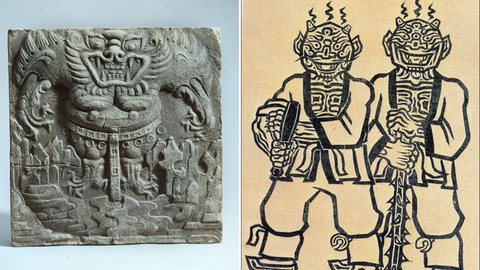KOREAN MYTHOLOGICAL CREATURES
Are you ready to discover some terrifying Korean mythological creatures? Some of them you might already have seen them in K-dramas. There are also different Korean mythological characters such as:
Gwisin - 귀신

(Image: Credits to the rightful owner)
In Korean folklore, Gwisin are a particular kind of ghost or spirit which are commonly compared to Yogoe and Mamul since they are deceased individuals rather than supernatural beings like Dokkaebi. It is told by Korean traditional folklore that these creatures can be found all throughout, since there is no specific place where people die. An individual's spirit is said to stay on earth to finish the work before moving on to the underworld when they pass away but still have connections to the living world, such as in the case of seeking revenge or taking care of a loved one.
These ghosts are legless, transparent, and typically float in the air. Cheonyeogwisin (female Gwisin), typically wear white Hanbok at funerals and depending on their personality, they can have faces and long, drooping black hair. On the other hand, male Gwisin are rather uncommon and can have diverse looks.
Dokkaebi/Goblin - 도깨비

(Image: Credits to the rightful owner)
These mythical beings from Korean folklore and mythology are commonly referred to as "Korean goblins," natural deities or spirits with amazing powers and skills who tend to interact with humans, sometimes pulling pranks on them and other times assisting them.
They are not created by a person's physical demise as Gwisin do, but rather by an inanimate object gaining spiritual control, such as discarded household items like brooms or things covered in human blood.
Joseung Saja/Grim Reaper - 저승 사자

(Image: Credits to the rightful owner)
Joseung Saja, also known as the Grim Reaper in other cultures, differs from others in both appearance and function. Many cultures consider grim reapers to be murderers or even wicked, but Joseung Saja known as Psychopomps, are beings, deities, or creatures whose role it is to lead recently deceased souls to the afterlife, guide them, not to condemn nor exterminate them.
Gumiho/Nine-Tailed Fox - 구미호

(Image: Credits to the rightful owner)
This mythological creature can be found in Korean and East Asian folklore. The Korean gumiho, Chinese huli jing and Japanese kitsune are very similar to one another, who frequently tries to lure boys and eats their liver or heart because it can freely shift into a beautiful woman, among other things. It appears in several stories, some of which can be found in the comprehensive Compendium of Korean Oral Literature, and some say these are where foxes who lived for thousands of years and were given the power of shapeshifting.
Mul Gwisin/Water Ghost – 물귀신

(Image: Credits to the rightful owner)
These creatures are ghosts that live in the water and are thought to have drowned. According to Korean tradition, Mul Gwisin frequently feel they are still alive and swim toward people who are still alive in the ocean to ask for assistance. It is usually an invisible force who drowns a person trying to replicate its horrible fate.
Scary fact: There is a myth not to swim or go near water during Halloween season, this is to prevent the water ghost to get you!
Dalgyal Gwisin/Egg Ghoast – 달걀귀신

(Image: Credits to the rightful owner)
The Egg ghost lacks a head, arms, legs, even eyes, a nose, or a mouth. According to lore, anyone who witnesses an egg ghost will pass away. There are rumors that some egg ghosts' characteristics can change over time, or that it may transform into an egg, hide, and then emerge whenever they like. Some academics believe that egg ghosts are a type of mujagui (childless ghost) since they lack descendants or other family members with whom to hold ancestor memorial services.
It is always important that these traditional folklore creatures are passed down to younger generations, it is a way to keep a culture’s history and customs alive. Among all these creatures which one do you fear the most? Let us know below!
Happy Halloween Seoulmates!
Author: SUJI SOHN
About the author: Suji was studying in London in the year 2019 and, although being separated from her family, her passion for Korea was growing. She noticed that a lot of her close friends loved Korean culture, food, music, and dramas and gradually started to fall in love with Korea, but there weren't many opportunities to actually "experience" this wonderful nation!
Suji was aware of what she needed to do to introduce Korea to her friends' lives and, conceivably, to those of everyone else who was curious about a piece of Daehan Min-guk.






